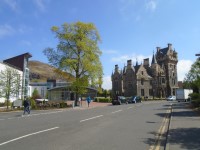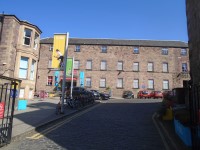Access Guide
Introduction
- The route from Pollock Halls of Residence to the Centre for Sports and Exercise is 0.9 miles. The route should take approximately 17 minutes to complete. The surfaces that you will need to overcome during the route include Block Paving, Brick Block Paving, Tarmac and tactile paving. There are easy and moderate gradients along the route.
- Related link Pollock Reception.
- Http://www.disabledgo.com/access-guide/the-university-of-edinburgh/pollock-halls-reception-centre
- Related link Centre for Sports and Exercise.
- Http://www.disabledgo.com/access-guide/the-university-of-edinburgh/centre-for-sports-and-exercise
Pollock Halls
- There are numerous small car parks throughout Pollock Halls for vistitors and staff only.
- There are several exits from the Halls. This route plan exits the halls via the route onto Holyrood Park Road.
Pollock Halls to Holyrood Park Road
- Turn left for 33m as you exit Pollock Halls and use the pedestrian crossing to cross Holyrood Park Road.
- As you leave Pollock Hall turn left.
- There is a tactile drop kerb which you will need to bypass.
- The surface of the pavement is block paving.
- On both sides of the road and the island there are drop kerbs.
- There are traffic lights located here.
- As you head towards the island from the near side of the road traffic is coming from the right. As you head from the island to the far side of the road traffic approaches from the left.
Holyrood Park Road to Dalkeith Road
- Turn left up Holyrood Park Road for 150m to reach Dalkeith Road
- The surface of the pavement is block paving with manhole covers.
- There is a slight gradient towards the road.
- After approximately 33m there is a service road that must be overcome which has tactile drop kerbs on either side and a central tactile island with drop kerbs. This can be seen in photograph 2.
- After crossing the road, continue on until you reach Dalkeith Road.
Dalkeith Road to Parkside Terrace
- Turn right for 130m down Dalkeith Road until you reach Parkside Terrace
- As you turn the corner onto Dalkeith Road there is tactile paving for a pedestrian crossing which can be seen in photographs 1 & 2. Cross over the paving and continue down Dalkeith Road.
- The surface of the pavement is block paving with manhole covers.
- There is a slight gradient towards the road.
- There are two sets of traffic lights with tactile drop kerbs across Dalkeith Road.
Cross Parkside Terrace
- There are drop kerbs on either side.
- The near side is block paving the far side is concrete. Neither side has tactile paving.
- The road is tarmac with a camber in the middle.
- Traffic approaches this road from both directions.
Dalkeith Road to St Leonard's Street
- Head down Dalkeith Road for 90m until it becomes St Leonard's Street
- The surface of the pavement is concrete with the occasional manhole covers.
- There is a slight gradient towards the road.
- There is a downhill gradient as you head down the hill.
- There is a bus stop along the pavement after 65m. This can be seen in photograph 3.
- After another 25m the Dalkeith Road comes to an end and St Leonard's Street begins.
- There is no clear distinction or separation between Dalkeith Road and St Leonard's Street on this side of the pavement. The easiest way to tell where Dalkeith road becomes St Leonard's street is that you can see Lutton Place on the other side of road.
St Leonard's Street
- For 65m continue along St Leonard's Street.
- The surface of the pavement is concrete with the occasional manhole cover.
- There is a slight gradient towards the road.
- There is a downhill gradient as you head down the hill.
- There is a service road with drop kerbs on either side after 50m as can be seen in photographs 2 & 3.
St Leonard's Street to Parkside Street
- For 80m continue along St Leonard's Street until you reach Parkside Street.
- After 35m there is a bus stop blocking the pavement, which can be seen in photograph 3.
- To get around it head to your right over an area that is a mixture of cobbled and block paved surfaces. Shown in photographs 4 & 5.
- After this return to the pavement. This area can be seen in photograph 6.
- Continue along St Leonard's Street until you reach Parkside Street.
Cross Parkside Street
- There are tactile drop kerbs either side of the road.
- The surface of the road is tarmac.
- After crossing over the road, you will need to travel over a cycle path there is tactile paving on either side.
- The road is tarmac with a camber in the middle.
- Traffic approaches this road from both directions.
St Leonard's Street to St Leonard's Lane
- After crossing Parkside Street, continue for 95m along St Leonard's Street until you reach St Leonard's Lane.
- After 12m there is tactile paving for a pedestrian crossing across St Leonard's Street. This can be seen in photograph 2.
- The surface of the pavement is concrete with the occasional manhole cover.
- There is a slight gradient towards the road.
- There is a downhill gradient as you head down the hill.
- There is a cycle path to the left of the pavement.
- After 40m there is a tarmac service road with tactile paving on each side. The road is level with the pavement. This can be seen in photograph 3.
- After which continue along St Leonard's Street to St Leonard's Lane.
Cross St Leonard's Lane
- There are tactile drop kerbs on either side of the road.
- The surface of the road is tarmac.
- Traffic approaches this road from both directions.
St Leonard's Street to Bowmont Place
- Continue along St Leonard's Street for 150m until you reach Bowmont Place
- There is tactile paving in front of you to mark the end of the cycle path.
- There is then blistered tactile paving to mark a crossing over St Leonard's Street.
- There is another small patch of tactile paving to mark the end for the cycle path (as seen in photograph 2).
- There is a tactile patch of paving for a set of traffic lights to cross St Leonard's Street after 10m from St Leonard's Land. This can be seen in photograph 3.
- The surface of the pavement is block paving to the left and cobbled to right with the occasional manhole covers. There are trees planted in the middle of this pavement (as shown in photographs 3 & 4).
- There is a slight gradient towards the road.
- There is a downhill gradient as you head down the pavement.
- There is a bus station taking up a large section of the pavement after approximately 53m. Move around this and continue to Bowmont Place. The bus station can be seen in photograph 5.
Cross Bowmont Place
- There are tactile drop kerbs on either side of the road.
- The surface of the road to the left of the crossing is tarmac and the surface to the right of the crossing is cobbled.
Pleasance to Service Road for Pleasance 178 - 184
- After crossing Bowmont Place head along Pleasance for 110m.
- The surface of the pavement is concrete.
- There are slight gradients uphill and to the road.
- After approximately 24m from Bowmont Place there is tactile paving for a crossing across Pleasance (as seen in photograph 3).
- After this, continue along Pleasance for approximately 71m where there is a concrete side road with tactile paving on each side. This can be seen in photograph 7.
Cross Service Roads for 178 - 184 and 142 - 156 Pleasance
- There is a tactile drop kerb leading onto a tarmac road.
- There is then a central island with tactile drop kerbs on either side.
- The 142-156 road is level with the pavement and is tarmac.
- There is a drop kerb on the far side.
Pleasance to Brown Street
- For 85m continue along Pleasance until you reach Brown Street.
- The surface of the pavement is block paving with the occasional manhole cover.
- There is a tactile crossing to your left after approximately 10m (as shown in photograph 2).
- There is a slight gradient towards the road.
- There is a slight downhill gradient.
- There is pedestrian crossing as you approach Brown Street after 65m with tactile paving along the pavement (as shown in photograph 4).
Cross Brown Street
- There are tactile drop kerbs either side of the road.
- The surface of the road is tarmac.
Cross New Arthur Place
- There are tactile drop kerbs on either side of the road.
- The road is tarmac.
Pleasance to New Arthur Place
- After crossing Brown Street continue along Pleasance to New Arthur Place a distance of 95m.
- The surface of the pavement is concrete with the occasional manhole covers.
- There is a slight gradient towards the road.
- There is a slight downhill gradient for the most part, but as you approach New Arthur Place it becomes an uphill gradient.
Pleasance to the Centre for Sports and Fitness
- After crossing New Arthur Street, continue along Pleasance for 108m until you reach the Centre for Sports and Fitness.
- The surface of the pavement is concrete with the occasional manhole cover.
- There is a slight gradient towards the road.
- There is a downhill gradient as you head down the hill.
- As you continue there are two separate service roads with drop kerbs on each side and a concrete road in the middle to access 60 Pleasance.


